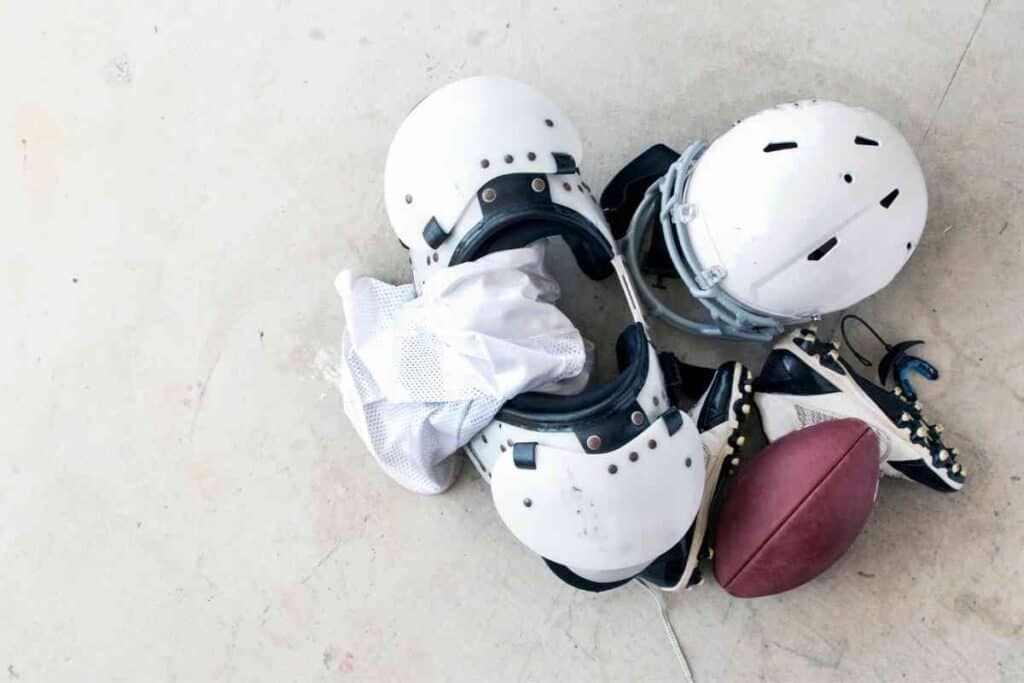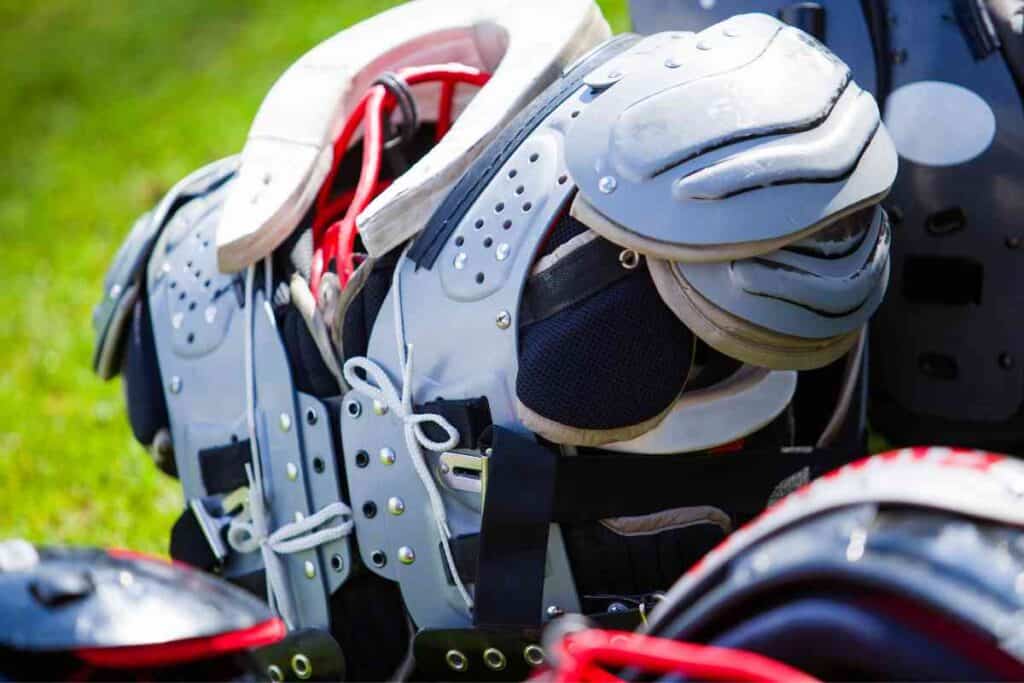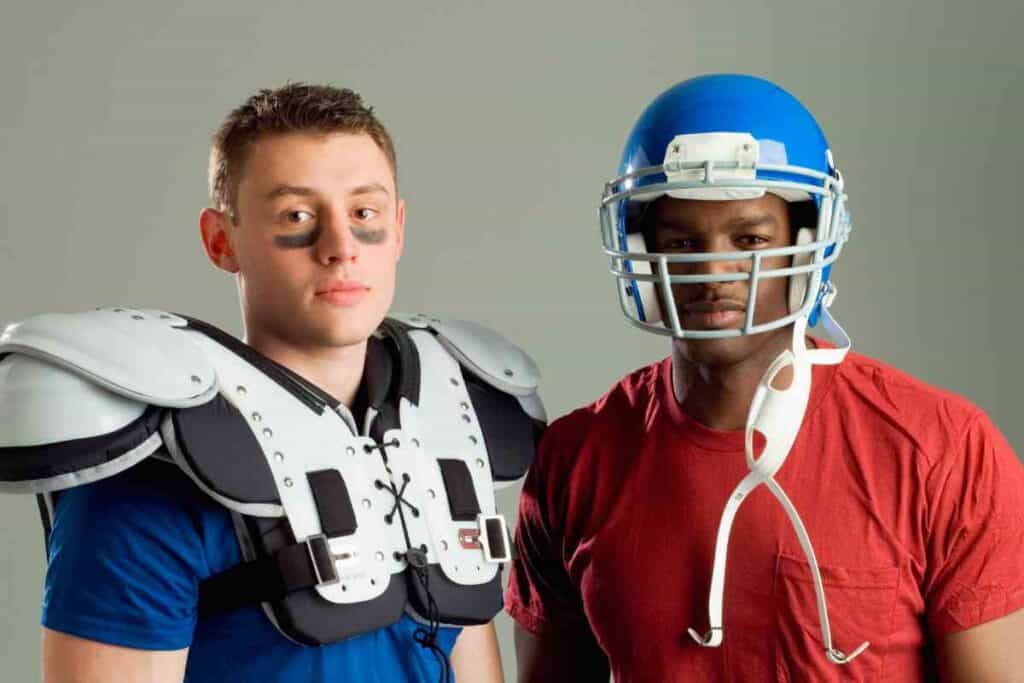How Much Does High School Football Gear Weigh?
High School football players can wear a fair bit of equipment to protect their body from the physical impacts of the sport. But how much does high school football gear weigh?

How Much Does High School Football Gear Weigh?
Between all their gear, ranging from a helmet to shoulder pads, cleats, a mouthguard, and thigh pads, many high school football players will be wearing 15 or more pounds of gear on game day. This does vary a bit based on what position they play and the type of gear they wear.
We’ll review some of the safety gear high school football players wear during a game, how much it weighs, and what the actual range of weight carried is for a football player.
Helmets
A high school football player helmet consists of a strong, heavy outer shell, and soft inner core that is meant to protect the brain from taking an impact.
Players also have a face mask to prevent knees, fingers, and other body parts from hitting them in the face or – these can weigh t a few ounces as well.
A helmet typically weighs 5 to 6 pounds. The helmet is so important that removing it on the field while a play is in progress or after the play is often considered a penalty.
It might be worth noting that manufacturers don’t tend to include the weights of their helmet within their specs. Sometimes the weight of the helmet does matter for high school football players!
Football jersey weight

The jersey is one of the lighter pieces of equipment for a high school football player. While a high school football jersey can be big – it doesn’t weigh that much at about a pound.
There also isn’t much variance here.
Shoulder pads weight
Here is where we’ll see the largest variety in weight amongst different positions within football. We’ll say the typical range of weight is about 3 to 6 points, which is relatively light compared to what it was years ago.
An offensive or defensive lineman – those tasked with either protecting the quarterback and running back, or pursuing the quarterback or running back, will have the heaviest, thickest pads because they are taking some kind of hit nearly every play.
These will often have a harder outer shell to protect your ribs and organs while also lacking straps so they can’t be grabbed. These can weigh upwards of 6 pounds.
A wide receiver, running back, or defensive back tends to have pads on the lighter end – around 3 pounds as they need to be very agile and doesn’t absorb hits quite as often as the front line players.
Part of the loss in weight comes from shorter, skinnier pads around the shoulders and less hard shell.
Quarterback pads also tend to be very light and offer significant protection for the shoulders while also not adding much weight up there for range of motion in throwing. These mimic a wide receivers pad more
Pants weight
You might not even notice that football players are wearing shin or thigh pads – but they are often required to.
The combination of pants and thigh or shin pads often weighs around 3 to 5 pounds.

Football shoes
Better known as cleats, these are typically only slightly heavier than traditional shoes because of a small amount of padding and the addition of plastic cleats inserted into the bottom. These can weigh from 6 to 10 punches.
Isn’t that a lot of weight?
Considering the amount of working out football players do – and the literal need for padding, the weight isn’t something most players complain about unless they are first starting out.
You might recall seeing photos of football players prior to the 1960s wearing leather helmets and bulky pads.
Modern plastics and foams have helped reduce the weight of pads overall.
Football has changed a lot
From players in leather helmets to running backs and defensive linemen looking rather bulky in old photos – football itself has change significantly.
Football teams used to rely much more heavily on the run game, and with it and 11 players per side, over a dozen collisions per play in most cases.
With more passing happening than ever, the players themselves only do what is required because while they are as fast and as strong as ever, they aren’t quite being sent to the same kind of grind every play.
Newer materials for pads offer a better blend of the right weight that doesn’t affect performance with the needed risk reduction from throwing a hit.
The number of concussions in high school football is reportedly down significantly with better helmets and overall better pads reducing the chance of a jostling of the brain.
Related Reading
- Do High School Football Teams Provide Equipment?
- Understanding High School Football Heat Rules
- How Much Does A College Football Helmet Weigh?
- Do You Have to Wear Knee Pads in High School Football?
- Can you play high school football at 18
- Can high school football players get paid?
- What Size Is a High School Football Field?
- How much do college football uniforms cost?
Key Takeaways
- A high school football player’s pads might weigh from 15 pounds on up for a lineman and a bit less for a wide receiver or quarterback
- The heaviest part is often the helmet or shouldes pads with a bigger range for shoulder pads. The helmet is usually consistently 4 to 6 pounds.
- Football pads have changed significantly even in the last 30 years to offer more protection with less weight
